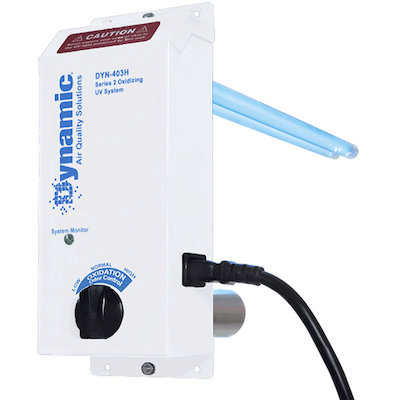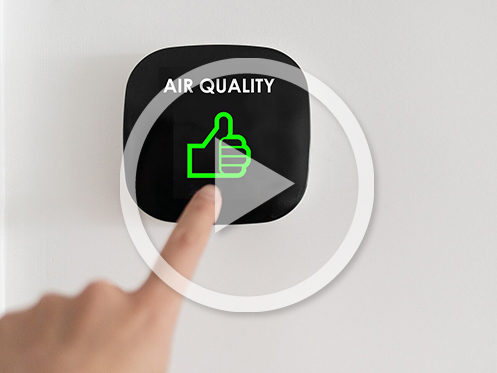Carbon monoxide is one of the most notorious home pollutants. It is an odorless, colorless, and tasteless gas that is toxic to humans. According to the Centers for Disease Control and Prevention (CDC), approximately 400 individuals die from unintentional carbon monoxide exposure in the U.S. each year. Over 100,000 people rush to the emergency room due to exposure, and over 14,000 individuals require hospitalization. And because carbon monoxide lacks usual signs of toxicity like taste or odor, this gas is often rigid to detect before it is too late. An overview of identifying carbon monoxide problems can help ensure a healthy indoor environment for yourself and your family.
What Causes the Production of Carbon Monoxide?
Carbon monoxide is the result of incomplete combustion of fuel. Many fuel types, including wood, natural gas, propane, and charcoal, can produce carbon monoxide. When the carbon atoms in fuel materials fail to oxidize fully, they form a triple bond with oxygen atoms to create carbon monoxide. This production can occur rapidly in tightly enclosed or poorly ventilated spaces. Automotive exhaust, faulty HVAC equipment, and factory emissions can also release carbon monoxide gas into the environment. Virtually any non-electric machine can produce carbon monoxide gas on your property.
How Does Carbon Monoxide Poisoning Occur?
Carbon monoxide poisoning occurs when individuals inhale these toxic fumes. When there is too much carbon monoxide in the environment, the human body replaces the oxygen in red blood cells with carbon monoxide molecules. This happens because the structure of carbon monoxide enables it to attach to hemoglobin in blood cells much faster than oxygen can reach these cells. Hemoglobin is responsible for transporting oxygen throughout the body. Upon excess carbon monoxide exposure, a person’s blood absorbs toxic molecules and fails to replenish necessary oxygen. The lack of oxygen can damage bodily tissues and vital organs like the brain, lungs, and heart. Eventually, inhaling this gas can result in permanent organ damage or death.
Familiar Sources of Carbon Monoxide in the Home
Carbon monoxide can show up any time a machine or appliance burns fuel. Household items like the family car, gas range, furnace, charcoal grill, boiler, or fireplace can all emit carbon monoxide into the home or garage. Other possible sources of carbon monoxide can include the following:
- Portable heating systems or space heaters
- Boilers or gas water heaters
- Gasoline-powered equipment or power tools
- Portable generators
Signs of Carbon Monoxide Leaks in the Home
Carbon monoxide is nicknamed the “silent killer” because you cannot see, smell, or taste it. However, there are still a few ways to detect possible leakage or buildup within areas of the home:
- Sooty, brownish, or yellowish stains around appliances
- Heavy condensation around appliances
- Stale or stuffy room air
- There is no upward draft in the chimney flue
- The pilot light on the appliance frequently goes out
- Yellow burner flames in your furnace
If you notice any signs of leakage or emission, contact a professional promptly. An expert can help confirm whether you have a dangerous carbon monoxide issue. For example, an expert can determine whether heavy window condensation results from dangerous poison exposure or indicates excessive humidity within the home. The technician can then work with you to correct the carbon monoxide leak or to solve humidity issues in your home.
Who Is at Risk for Carbon Monoxide Poisoning in the Home?
Everyone is at risk for carbon monoxide poisoning. According to the University of Pennsylvania School of Medicine, carbon monoxide gas is the leading cause of poisoning death in the United States. While anyone can get sick from carbon monoxide exposure, some populations are at greater risk for the most severe complications or death. These people include individuals with respiratory conditions like asthma, emphysema, or cardiovascular disease. Individuals undergoing chemotherapy or who have compromised immune systems and people with chronic anemia or sickle cell anemia are also at risk.
Even people without known illnesses can suffer significantly due to age or life circumstances. Infants, young children, and older adults are vulnerable to complications from exposure. Pregnant or nursing women can go into shock from carbon monoxide exposure, and the poison can also harm an unborn fetus.
What Are the Symptoms of Carbon Monoxide Poisoning?
Extreme carbon monoxide exposure is a medical emergency. People who inhale too much of the gas all at once can lose consciousness and suffocate within minutes. However, the symptoms are more challenging to detect if there is a gradual leak or emission. Home occupants exposed to toxic carbon monoxide can display any of the following symptoms:
- Headaches
- Dizziness or confusion
- Shortness of breath
- Nausea or vomiting
- Blurred vision
- Drowsiness or fatigue
- Muscle weakness
- Fainting
How to Lower the Risk of Carbon Monoxide Poisoning
The first step in avoiding carbon monoxide poisoning is to schedule an annual home inspection. A professional technician can check gas appliances, chimneys, and vents. It is essential to work with professionals since they have the equipment and training to detect any issues. They also know how to help you find solutions. A professional technician can also install battery-operated carbon monoxide alarms at every level of the home. Battery-operated alarms can work even if you are experiencing a power outage. Consider placing alarms directly above the riskiest fuel-burning appliances like furnaces or water heaters. You should test these alarms regularly and replace them at least every ten years. You can purchase the same alarms for motor homes, boats, and sheds.
In addition to leakage issues, poison exposure can occur from mistakes like running the car exhaust within an enclosed garage or using a charcoal grill indoors. Lower your risk by knowing the rules of home safety. For example, always open a garage door before starting a car, and never leave the car running in the garage. Ensure gas appliances are properly vented, and never patch vents with duct tape. If you need help with vents, contact a professional HVAC company instead.
Finally, another way to stay safe is to leave enough space around all fuel-burning appliances. According to the CDC, using portable generators during power outages is a rising cause of carbon monoxide death. Power generators can produce more carbon monoxide gas than a small car and can cause death in a short amount of time. Never run generators in an enclosed space like a basement or garage. Place these generators at least 25 feet away from your house.
Contact the Professionals
At Golden Rule, we are a family-owned business serving homeowners for more than 25 years. We also provide plumbing, electrical, and indoor air quality services. If you are concerned about carbon monoxide or other air quality issues in your home, we can conduct air quality testing and suggest solutions. We can also install or replace smoke and carbon monoxide alarms. Contact Golden Rule today to schedule an appointment with one of our technicians.

Shine a Light on Cleaner Living: The Dynamic Germicidal UVC Lamp Review Have you ever wondered about the unseen invaders lurking in your home? Well, fear not,... Read More

Breathe Easy: 5 Strategies to Improve Indoor Air Quality in Your Home Hey there, homeowner! Are you tired of feeling like you’re breathing in a cloud of... Read More

As a homeowner, ensuring optimal comfort in your living space is paramount. Your HVAC (Heating, Ventilation, and Air Conditioning) system is crucial in maintaining the desired temperature... Read More